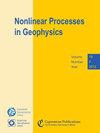Uncertainties, complexities and possible forecasting of Volcán de Colima energy emissions (Mexico, years 2013–2015) based on a fractal reconstruction theorem
IF 1.7
4区 地球科学
Q3 GEOSCIENCES, MULTIDISCIPLINARY
引用次数: 0
Abstract
Abstract. The effusive–explosive energy emission process in a volcano is a dynamic and complex physical phenomenon. The importance of quantifying this complexity in terms of the physical and mathematical mechanisms that govern these emissions should be a requirement for deciding to apply a possible forecasting strategy with a sufficient degree of certainty. The complexity of this process is determined in this research by means of the reconstruction theorem and statistical procedures applied to the effusive–explosive volcanic energy emissions corresponding to the activity in the Volcán de Colima (western segment of the Trans-Mexican Volcanic Belt) along the years 2013–2015. The analysis is focused on measuring the degree of persistence or randomness of the series, the degree of predictability of energy emissions, and the quantification of the degree of complexity and “memory loss” of the physical mechanism throughout an episode of volcanic emissions. The results indicate that the analysed time series depict a high degree of persistence and low memory loss, making the mentioned effusive–explosive volcanic emission structure a candidate for successfully applying a forecasting strategy.基于分形重建定理的科利马火山能源排放的不确定性、复杂性和可能的预测(墨西哥,2013-2015 年
摘要火山的喷出-爆炸能量释放过程是一种动态而复杂的物理现象。从物理和数学机制的角度对这种复杂性进行量化的重要性,应该是决定采用具有足够确定性的预测策略的必要条件。本研究通过重构定理和统计程序确定了这一过程的复杂性,这些定理和程序适用于 2013-2015 年科利马火山(跨墨西哥火山带西段)活动相应的喷出-爆炸火山能量排放。分析的重点是测量序列的持续性或随机性程度、能量排放的可预测性程度,以及量化整个火山排放过程中物理机制的复杂程度和 "记忆丢失 "程度。结果表明,所分析的时间序列具有较高的持续性和较低的记忆损失,使上述喷出-爆发式火山排放结构成为成功应用预测策略的候选方案。
本文章由计算机程序翻译,如有差异,请以英文原文为准。
求助全文
约1分钟内获得全文
求助全文
来源期刊

Nonlinear Processes in Geophysics
地学-地球化学与地球物理
CiteScore
4.00
自引率
0.00%
发文量
21
审稿时长
6-12 weeks
期刊介绍:
Nonlinear Processes in Geophysics (NPG) is an international, inter-/trans-disciplinary, non-profit journal devoted to breaking the deadlocks often faced by standard approaches in Earth and space sciences. It therefore solicits disruptive and innovative concepts and methodologies, as well as original applications of these to address the ubiquitous complexity in geoscience systems, and in interacting social and biological systems. Such systems are nonlinear, with responses strongly non-proportional to perturbations, and show an associated extreme variability across scales.
 求助内容:
求助内容: 应助结果提醒方式:
应助结果提醒方式:


